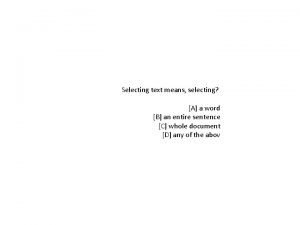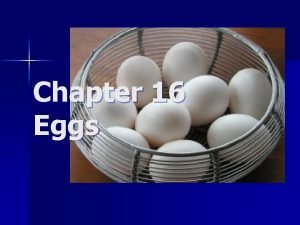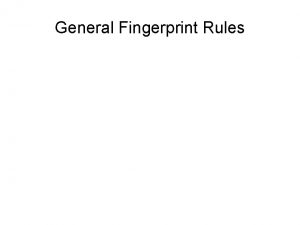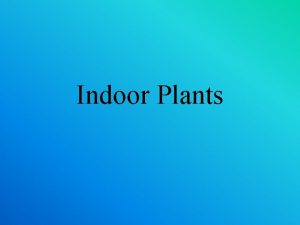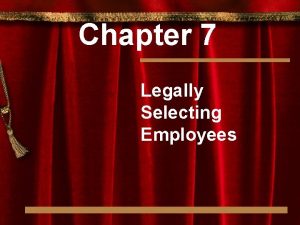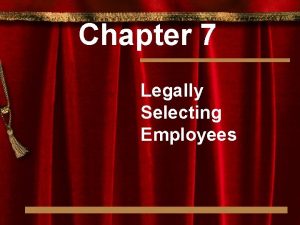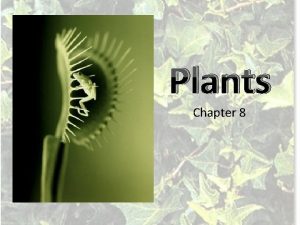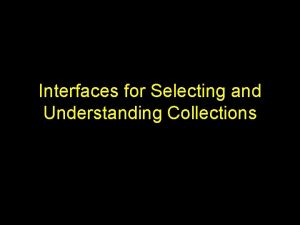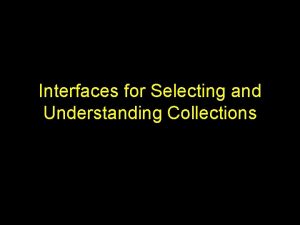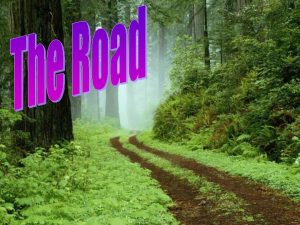Selecting Plants for the Design Chapter 7 Plants















































- Slides: 47

Selecting Plants for the Design Chapter 7

Plants: Building Blocks of the Landscape w The residential landscape is made of different elements. They are the plant materials and the physical structures. w Physical structures in the landscape are patios, walls, fences,

Plants: Building Blocks of the Landscape w Plant Types: n n n n Trees Shrubs Groundcover Vines Annuals Perennials Ornamental Grasses

Plants: Building Blocks of the Landscape w Trees: n can be defined as a single stem, woody, perennial plant reaching the height of 12 feet or more

Plants: Building Blocks of the Landscape w Shrubs: n n are multi-stem, woody plants that do not exceed 20 feet in height. In general shrubs are usually as tall as they are wide. They may be deciduous or evergreen Some examples of shrubs are: viburnums, honeysuckles, spireas, hollies, junipers and yews

Plants: Building Blocks of the Landscape w Ground cover: n n May be woody or herbaceous. It forms a mat less than 1 foot high covering the ground. Grasses is the most common plant used as a ground cover. Examples of other ground covers are: English ivy, periwinkle (vinca) euonymus , and Japanese spurge

Plants: Building Blocks of the Landscape w Vines: n n are woody or herbaceous (soft stemmed) plants that require some type of support. They may climb on objects or creep along the ground. Some examples of vines are: Boston ivy, wisteria, and clemtis

Plants: Building Blocks of the Landscape w Annuals: n n Are herbaceous plants that live for one growing season and are valued for the color of their flowers or ornamental foliage adds to the landscape. Common annuals are : Impatiens, marigolds, petunias, coleus, and zinnias

Plants: Building Blocks of the Landscape w Perennials: n n is a plant that has a life cycle of more than two growing seasons. They may be called woody as with trees and shrubs or herbaceous. Some popular perennials are: daylilies, peonies, lilies, and iris.

Plants: Building Blocks of the Landscape w Ornamental Grasses: n Are valued for their texture and colors that add interest to the landscape. Ornamental grasses can be annuals or perennials. Some grow best in warm climates while others prefer cool climates

Plants: Building Blocks of the Landscape w What is plant nomenclature? n n n it is the naming of the plants. All plants have two types of names: Common Name Botanical Name

Plants: Building Blocks of the Landscape w What is the genius? n it is closely related group of plants comprised of one or more species

Plants: Building Blocks of the Landscape w What is a species? n it is composed of plants that show characteristics that distinguish them from other groups in the genius

Plants: Building Blocks of the Landscape w What is a variety: n Is a group of plants within a species that show a significant difference from other plants in the species.

Plants: Building Blocks of the Landscape w What is a cultivars? n a plant with a distinguishing characteristic from other plants in the species but does not transfer that characteristic to it off spring through sexual reproduction

Selecting Plants w Trees: n n n Are the largest and most permanent plant material used in landscaping Trees that are smaller and have a higher ornamental value are often called ornamental trees. Examples of ornamental trees are flowering dogwoods, flowering crabapples, redbud, and Japanese maple.

Selecting Plants w Trees: n Hardiness refers to the ability of a tree to withstand cold temperatures. Trees have differing abilities to survive in areas in the United States.

Selecting Plants w Trees: n choose resistant to disease and insect problems. If a tree has beautiful characteristics but is susceptible to insect infections and diseases, its value is reduced

Selecting Plants w Trees: n n They may also have a common problem involving the p. H of the soil. p. H is a measure of acidity and alkalinity of the soil p. H scale ranges from a extremely acid reading of 1 to and extremely alkaline reading of 14. A neutral reading is 7. Most plants prefer a p. H between 5. 5 and 7. 0

Selecting Plants w Shrubs: n n Shrubs can have multiple functions in the landscape. The can be used as specimen plants, group plantings, hedges, screens, foundation plants, or shrub borders. Select shrubs on their intended use. Also consider their flowers, foliage, branching habits, and their suitability to the growing conditions

Selecting Plants w What is a Specimen Plant? n it displays outstanding form, texture, and color. The plant can also stand alone

Selecting Plants w What is a group planting? n consist of several different species of shrubs. They are considered a overlapping plant that will reach over plants to form a huge mass.

Selecting Plants w What is a Hedge? n n n consist of all one type of shrub. The define space , they tie other landscapes elements together and they may screen views They can range from 20 feet to 1 foot high. They can be clipped for a formal appearance or unclipped for an informal natural look.

Selecting Plants w What is a Screen? n is a solid mass of one type of shrub. It serves as a living wall that effectively blocks views.

Selecting Plants w What is a foundation plant? n Are shrubs placed around the foundation of the house. They help tie the house to the landscape by softening the corners and they block the view of the foundation

Selecting Plants w What is a shrub border? n A mass of many shrubs on the border of the property. They help create the outdoor living area, screen views, and serve as a backdrop for annual and perennial flowers

Drawing Plants into your Plan w It is helpful to use symbols in your design work that represents the different types of plants. The symbols styles used vary from one designer to the other.

Drawing Plants into your Plan w Here are some examples of plant symbols n n n n n Deciduous Tree Evergreen Tree Broadleaf Evergreen tree Deciduous shrubs Evergreen shrubs Deciduous Hedge Evergreen Hedge Broadleaf Evergreen Hedge Cobbles -- Ground Cover --Gravel

Drawing Plants into your Plan w Labeling: n The most important thing after drawing in your plants is to label each one and to make sure to keep thing nice and neat to read.

Lets Review!! w w w The Design Steps!! Step 7 Locate Trees on the plan Step 8 Locate Shrubs Step 9 Assign textures and colors Step 10 Select plants to meet needs Step 11 Trace the plan on to quality vellum. Draw plant symbols on the good plan w Step 12 Label everything

Geometry for the Landscape

Objectives w By the end of this lesson you will be able to calculate: n n n the perimeter of a given section of land the area of given section of land the volume of container

Terms w diameter (d)- the line that divides a circle into two equal parts w radius ( r)- one half the diameter w pi ( ) - 3. 14 or 22/7 w height- line segment that shows how tall a triangle is. It is always drawn from a corner of the triangle to the opposite side forming a 90 degree angle.

Terms continued w perimeter(P)- the distance around n n the sum of all sides How much fence do you need to go around a yard? w Circumference (C)- perimeter of a circle n n C= diameter X How much edging do you need to go around a flower bed?

Terms Continued w volume (V)- how much fits in a given space n n n Volume of a box= area of bottom X height Volume of a sphere+ 4/3 X pi X radius How much soil do you need to fill a flower pot?

More Terms w area (A)- the space inside the perimeter n n rectangle= side X side triangle= (base X height)/2 circle= radius X How many square feet of sod do you need to order to cover the yard?

Example of perimeter

Examples of area rectangle

Examples of area circle

Examples of Area of Triangle

Volume

Notes w If a shape is not standard break it down into smaller standard shapes to make calculations w Calculations must be done in the same unit of measurement (change feet to inches or vice versa as needed) w Simplify all answers, do not write feet as decimals, convert to inches.

Units w Perimeter- feet, inches, cm, m, mm, yards……. w Area- sq. feet, sq. inches, sq. cm, sq. yards…. . . w Volume- cubic feet, cubic inches, cubic cm, cubic yards…….

Homework problems 1. How many cubic feet of mulch do you need to buy if you are mulching a 3 foot ring three inches deep around 4 trees that are 1 foot each in diameter? 2. How much soil is needed to fill 24 planters that are 1 ft wide, 6 feet long, and 1 ft 6 inches deep?

4. How many sq. feet of sod would be needed to cover the yard at the right? 38’ 72’ 3. Find the perimeter of the yard to the right.

5. If three inches of snow had to be removed from a walk pictured below, how many cubic ft of snow would be removed? 50’ 8’ 12’ 46’

The End w Any Questions!!
 Selecting text means selecting
Selecting text means selecting Chapter 17 eggs selecting and storing eggs
Chapter 17 eggs selecting and storing eggs Chapter 7 selecting the channel members
Chapter 7 selecting the channel members Chapter 5 selecting a topic and a purpose
Chapter 5 selecting a topic and a purpose Chapter 5 selecting a topic and a purpose
Chapter 5 selecting a topic and a purpose Formuö
Formuö Hris selection criteria
Hris selection criteria Investment risk example
Investment risk example Portrait ipn mould guide
Portrait ipn mould guide The relational database model enables you to view data
The relational database model enables you to view data Recruiting for international assignments
Recruiting for international assignments Typiska drag för en novell
Typiska drag för en novell Nationell inriktning för artificiell intelligens
Nationell inriktning för artificiell intelligens Returpilarna
Returpilarna Varför kallas perioden 1918-1939 för mellankrigstiden?
Varför kallas perioden 1918-1939 för mellankrigstiden? En lathund för arbete med kontinuitetshantering
En lathund för arbete med kontinuitetshantering Adressändring ideell förening
Adressändring ideell förening Tidbok för yrkesförare
Tidbok för yrkesförare A gastrica
A gastrica What are the rules in the selection of core and delta?
What are the rules in the selection of core and delta? In urban traffic you should look
In urban traffic you should look Vad är densitet
Vad är densitet Datorkunskap för nybörjare
Datorkunskap för nybörjare Identifying and selecting systems development projects
Identifying and selecting systems development projects Selecting investment in global market
Selecting investment in global market Acquiring information systems and applications
Acquiring information systems and applications Boverket ka
Boverket ka Debatt artikel mall
Debatt artikel mall Potential market
Potential market Delegerande ledarskap
Delegerande ledarskap Nyckelkompetenser för livslångt lärande
Nyckelkompetenser för livslångt lärande Påbyggnader för flakfordon
Påbyggnader för flakfordon Kraft per area
Kraft per area Offentlig förvaltning
Offentlig förvaltning Nnn promotions interview questions
Nnn promotions interview questions Jag har gått inunder stjärnor text
Jag har gått inunder stjärnor text Presentera för publik crossboss
Presentera för publik crossboss Argument för teckenspråk som minoritetsspråk
Argument för teckenspråk som minoritetsspråk Vem räknas som jude
Vem räknas som jude Treserva lathund
Treserva lathund Fimbrietratt
Fimbrietratt Claes martinsson
Claes martinsson Cks
Cks Explain the criteria for choosing brand elements
Explain the criteria for choosing brand elements Lågenergihus nyproduktion
Lågenergihus nyproduktion Mat för unga idrottare
Mat för unga idrottare Verktyg för automatisering av utbetalningar
Verktyg för automatisering av utbetalningar Rutin för avvikelsehantering
Rutin för avvikelsehantering
